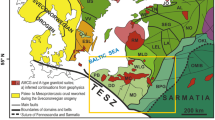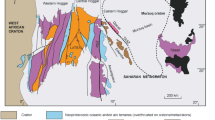Summary
A Cu-Mo-bearing granitoid belonging to the concealed Precambrian crystalline basement of Lithuania has been dated by the U-Pb zircon method and investigated geochemically. chemically. The granitoid is located at Kabeliai in southernmost Lithuania and forms part of a granitoid complex recognized as the Marcinkonys batholith. The Kabeliai granite is composed of quartz, plagioclase, microcline and biotite and shows a granitic to adamellitic peralummous/metaluminous composition with dominantly I-type chemistry. U-Pb dating of zircon yields an age of 1505 ± 11 Ma, which is considered to reflect the crystallization age of the granite.
The Kabeliai granite displays several similarities in terms of geological setting, chemistry and age with certain granitoids in northeastern Poland (Mazury complex) and northwestern Belorussia (Mostovsky, Kamensky and Vydgodsky plutons), which are considered “rapakivi-like” in the literature. It is, however, uncertain whether proper rapakivi granites really exist in these areas as none of these granitoids displays the common characteristics of rapakivi granites (A-type chemistry, wiborgitic textures, associated Sn-Be-Pb-Zn-Cu mineralizations). We speculate that the 1.4-1.5 Ga granites southeast of the Baltic Sea rather might be correlated with granites of comparable age and geochemical character in southwestern Sweden. Another possible alternative is that the granitoids in Lithuania may not be correlated with any part of the Fennoscandian Shield.
Zusammenfassung
Ein Cu-Mo-führender Granitoid, der zum präkambrischen, kristallinen Grundgebirge Litauens gehört, wurde mittels der U-Pb Methode an Zirkonen datiert und geochemisch untersucht. Der Granit repräsentiert einen Teil des Marcinkonys Batholithes, und tritt in Kabeliai, im südlichsten Litauen auf. Der Kabeliai Granit besteht aus Quarz, Plagioklas, Mikroklin und Biotit und zeigt adamellitische, peraluminöse/metaluminöse Zusammensetzung mit vorwiegend 1-Typ Charakter auf. U-Pb Datierung der Zirkone ergibt ein Alter von 1505 ± 11 Mio Jahren, das als Kristallisationsalter anzusehen ist.
In seinem geologischen mit Granitoiden im nordöstlichen Polen (Mazury Komplex) und Grant Ånlichkeiten mit Granitoiden im nordöstlichen Polen (Mazury Komplex) und Grant Ånlichkeiten mit Granitoiden im nordöstlichen Polen (Mazury Komplex) und im nordwestlichen Weißrussland (Mostovsky, Kamensky und Vydgodsky Plutone), die in der Literatur als “Rapakivi-ähnlich” angesehen werden. Es ist jedoch unischer ob echte Rapakivi-Granite in diesen Regionen existieren. Keiner dieser Granite zeigt nämlich die für Rapakivi-Granite typischen Kennzeichen (A-Typ Chemie, Wiborgit Texturen, assoziierte Sn-Be-Pb-Zn-Cu-Mineralisationen). Wir vermuten, daß die 1.4 1.5 Mia Jahren alten Granite südöstlich der Ostsee eher mit Graniten ähnlichen Alters und von ähnlichem geochemischen Charakter im südwestlichen Schweden zu vergleichen sind. Eine weitere Alternative wäre, daß die Granitoide Litauens mit keinem Granit im Fennoskandischen Schild korreliert werden können.
Similar content being viewed by others
References
Ahl M, Mansfeld J, Sundblad K (1989) The Ramnebo Zn-Pb-Cu sulphide deposits in the Småland granitoids in southeastern Sweden. Symposium on Precambrian granitoids, Helsinki Geol Surv Finland Spec Pap 8: 6 (Abstract)
Aksamentova NV (1988) Evolution of the structure-formation during the Early Precambrium in the southwest of the East-European Platform. Doklad Akad Nauk BSSR 32: 433–436 (in Russian)
Avtushko MI (dy1983) Geochemistry, petrogenesis and potential ore-bearing granitoids of the Mostovsky complex (Belorussian Anticlise). Thesis, Gomel: 212 pp (in Russian)
Billström K, Åberg G, Öhlander B (1988) Isotopic and geochemical data of the Pingstaberg Mo-bearing granite in Bergslagen, south central Sweden. Geol Mijnbouw 67: 255–263
Boynton WV (dy1984) Cosmochemistry of the rare earth elements: meteorite studies. In:Henderson P (eded) Rare earth element geochemistry. Elsevier, pp 63–114
Bowden P, Whitley JE (1974) Rare-earth patterns in peralkaline and associated granites. Lithos 7: 15–21
Bugge A (dy1963) Norges molybdenforekomster. Nor Geol Unders 217: 1Bulkin JS (1989) Genetic classification and typomorphic pecularities of granitoids in the
Bulkin JS (1989) Genetic classification and typomorphic pecularities of granitoids in the Belorussian Anticlise. Nauka i technica, Minsk, pp 13–22 (in Russian)
Collins WJ, Beams SD, White AJR, Chappell BW (1982) Nature and origin of A-type granites with particular reference to southeastern Australia. Contrib Mineral Petrol 80: 189–200
Debon F, Le Fort P (1982) A chemical-mineralogical classification of common plutonic rocks and associations. Trans Royal Soc Edinburgh, Earth Sci 73: 135–149
Gaál G, Gorbatschev R (1987) An outline of the Precambrian evolution of the Baltic Shield. Precambrian Res 35: 15–52
,Isohanni M Isohanni M (1979) Characteristics of igneous intrusions and various wall rocks in some Precambrian porphyry copper-molybdenum deposits in Pohjanmaa, Finland. Econ Geol 74: 1198–1210
Haapala I (1977) The controls of tin and related mineralizations in the rapakivi-granite areas of south-eastern Fennoscandia. Geol Fören Stockholm Förh 99: 130–142
2 (1983) Metallogeny of Precambrian granitoids of Finland. In:Beus AA (ed) Metallogeny of Precambrian granitoids. Nauka, Moscow, pp 25–71 (in Russian with English abstract)
—(1989) Metallogeny of the Proterozoic rapakvi granites of Finland. In:Taylor RP,Strong DF (eds) Recent advances in the geology of granite-related mineral deposits. Canadian Inst Mining Metallogeny, Spec Issue 39: 124-132
—Rämö OT (1990) Petrogenesis of the Proterozoic rapakivi granites of Finland. In:Stein HJ,Hannah JL (eds) Ore-bearing granite systems. Petrogenesis and mineralizing processes. Geol Soc Am Spec Pap 246: 275-286
——(1992) Tectonic setting and origin of the Proterozoic rapakivi granites of southeastern Fennoscandia. Trans Royal Soc Edinburgh, Earth Sci 83
Front K,Rantala E, Vaarma M (1987) Petrology of Nattanen-type granite complexes, northern Finland. Precambrian Res 35: 225–240
Hübner H (1971) Molybdenum and tungsten occurrences in Sweden. Sver Geol Unders Ca 46: 29 pp
Johansson Å, Meier M, Oberli F, Wikman H (1993) The early evolution of the southwest Swedish Gneiss Province: geochronological and isotopic evidence from southernmost Sweden. Precambrian Res (in press)
—(1991) Age of the Önnestad syenites and some gneissic granites along the southern part of the Protogine Zone, southern Sweden. In:Gower CF,River T,Ryan B (eds) MidProterozoic Laurentia-Baltica. Geol Ass Can Spec Pap 38: 131–148
Larsen O (1989) Radiometric age determinations and Precambrian geochronology of Blekinge, southern Sweden. Geol Fören Stockholm Förh 111: 35–50
Johansson L, Lindh A, Möller C (1991) Late Sveconorwegian (Grenville) high-pressure granulite facies metamorphism in southwest Sweden. J Metam Geol 9: 283–292
Korsman K (ed) (1988) Tectono-metamorphic evolution of the Raahe-Ladoga zone. Geol Surv Finland Bull 343: 96 pp
Kranck EH (1945) The molybdenum deposit at Mdtäsvaara in Carelia (E. Finland). Geol Fören Stockholm Förh 67: 325–350
Krogh TE (1973) A low-contamination method for hydrothermal decomposition of zircon and extraction of U and Pb for isotopic age determinations. Geochim Cosmochim Acta 37:485–494
2 (1982) Improved accuracy of U-Pb zircon ages by the creation of more concordant systems using an air abrasion technique. Geochim Cosmochim Acta 46: 637–649
Lindh A, Johansson I (1991) Proterozoic granitoids in the Baltic Shield-the chemical composition of the Hinneryd granite. Geol Fören Stockholm Förh 113: 171–180
Ludwig KR (1991 a) PBDAT 1.21 for MS-DOS: A computer program for IBM-PC compatibles for processing raw Pb-U-Th isotope data. Revision of US Geol Surv open-file rep 88–542: 35pp
— (1991b) ISOPLOT A plotting and regression program for radoigenic-isotope data, version 2.53. Revision of US Geol Surv open-file rep 88-557: 39 pp
Manhes G, Minster JF, AWgre CJ (1978) Comparative uranium-thorium-lead and rubidiumstrontium study of the Saint Séverin amphoterite: consequences for early solar system chronology. Earth Planet Sci Lett 39: 14–24
Mansfeld J (1991) U-Pb age determinations of Småland-Värmland granitoids in Småland, south-eastern Sweden. Geol Fören Stockholm Förh 113: 113–119
Marfin S, Miksys RB, Motuza G, Skripkina T (1982) The structure of the Marcinkonys granitic massif and properties of rocks. Geologija (Lithuania) 3: 3–16 (in Russian)
2Motuza G, Mitrofanov F, Drubeckoi Yu, Nemchin A (1987) New dating of the crystalline basement in southern Lithuania. Geologija (Lithuania) 8: 3–9 (in Russian)
Motuza G, Bushmin SA, Suuroja KA (1987) A structural-compositional comparison between the rock complexes of the covered Precambrian basement in southern Lithuania and the granite-greenstone terranes of the Olekma river region, Aldanian Shield. Geology and perspectives of ore deposits in the paleoplatform. Nauka, Leningrad, pp 231–239 (in Russian)
Neymark LA, Amelin Yu V, Larin AM, Yakoleva SZ (1991) Geochronology and isotope geochemistry of the 1.54-1.57 Ga old Salmi anothosite-rapakivi granite batholith (North Ladoga Region, Soviet Karelia) Symposium on Rapakivi Granites and Related Rocks. Geol Surv Finland guide 34: 36 (Abstract)
Nurmi P, Haapala I (1986) The Proterozoic granitoids of Finland: granite types, metallogeny and relation to crustal evolution. Bull Geol Soc Finland 58: 203–233
Öhlander B (1988) Tectonic control and genesis of Proterozoic molybdenite occurrences in northern Sweden. Proceedings 7th IAGOD Symposium. Schweizerbartsche Verlagsbuchhandlung, pp 603–612
Ohlsson L-G (1979) Tungsten occurrences in central Sweden. Econ Geol 74: 1012–1034
Puura V, Apirubyte R, Birkis A, Gailius R, Motuza G, Ozolin N (1978) Geological map of the crystalline basement of the Soviet Baltic republics, scale 1 : 500000
Ryka W (1990) The crystalline basement of the Polish part of the Baltic. Kwartalnik Geol 34: 21–35 (in Polish with English abstract)
2 (1982) Fault tectonics of crystalline suckle of the Precambrian platform in Poland. Kwartalnik Geol26: 545–558 (in Polish with English abstract)
Shcherbak NP, Pap AM, Bartnitsky EN, Zayats AP (1990) The uranium-lead isotopic age of granitoids in Belorussia. Doklad Akad Nauk BSSR 34: 740–743 (in Russian)
Stacey JS, Kramers JD (1975) Approximation of terrestrial lead isotope evolution by a two-stage model. Earth Planet Sci Lett 26: 207–221
Steiger RH, Jäger E (1977) Subcommission on Geochronology: convention on the use of decay constants in geo- and cosmochronology. Earth Planet Sci Lett 36: 359–362
Sundblad K, Ahl M, Schöberg H (dy1993) Age and geochemistry of granites associated with Mo-mineralizations in western Bergslagen, Sweden. Precambrian Res (in press)
Vaasjoki M (1977) Rapakivi granites and other postorogenic rocks in Finland: their age and the lead isotopic composition of certain associated galena mineralizations. Geol Surv Finland Bull 294:1–64
2Rämö OT, Sakko M (1991) New U-Pb ages from the Wiborg rapakivi area: constraints on the temporal evolution of the rapakivi-anorthosite-diabare dyke association of southeastern Finland. Precambrian Res 51: 227–243
Velikoslavinsky DA, et al (15 authors) (1978) Anortosite-rapakivi granite formations. Doklad Akad Nauk SSSR, 296 pp (in Russian)
Vorma A (1976) On the petrochemistry of rapakivi granites with special reference to the Laitila massif, southwestern Finland. Geol Surv Finland Bull 285: 98 pp
Whalen JB, Currie KL, Chappell BW (1987) A-type granites: geochemical characteristics, discrimination and petrogenesis. Contrib Mineral Petrol 95: 407–419
White AJR, Chappell BW (1983) Granitoid types and their distribution in the Lachlan Fold Belt, southeastern Australia. Geol Soc Am Mem 159: 21–34
Wilson MR, Fallick AE, Hamilton PJ, Persson L (1986) Magma sources for some MidProterozoic granitoids in SE Sweden: geochemical and isotopic constraints. Geol Fören Stockholm Förh 108: 79–91
Author information
Authors and Affiliations
Rights and permissions
About this article
Cite this article
Sundblad, K., Mansfeld, J., Motuza, G. et al. Geology, geochemistry and age of a Cu-Mo-bearing granite at Kabeliai, southern Lithuania. Mineralogy and Petrology 50, 43–57 (1994). https://doi.org/10.1007/BF01160138
Received:
Accepted:
Issue Date:
DOI: https://doi.org/10.1007/BF01160138




